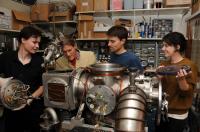Jan 31 2011
Scientists at the University of Arizona have procured information by measuring the attraction forces between atoms and surfaces. This development is expected to improve the way humans look at and understand atoms and nanotechnology. Details of the research results have been published in the Physical Review Letters.
Although the forces of Van der Waals are intrinsic in chemistry, biology and physics, their interactions are the weakest and hardly decipherable. However, this force can be felt strongly when using nanotechnology. According to Vincent Lonij, a research student of physics, this force of interaction can be made stronger by breaking up components into small atomic molecules. Lonij headed the research team at the university. If miniscule gears are fitted into a nano robot, they just gel together and come to a standstill.

In an endeavor to study this phenomenon, professor of physics, Alex Cronin led the team to design a setup that is used to measure interactions between an atom and a surface by deploying quantum mechanics. This helped them study the atoms both in the form of molecules and as waves. In the experiment, they passed the atom through a grate and measured the interaction crated when the atom touched the surface of the grate. This reaction attracted the atom to stick to the bars of the grate, which were pulled apart in the process. This further transformed the trajectory of the atom.
Van der Waals force causes attraction between any two objects. An atom is made up of thousands of molecules, neutrons, electrons etc, making research on the atom tough. Each of these components is charged in a differently and to a different level. This difference is what constitutes the van-der-Waals force.
The electrons in an atom are negatively charged, while the protons are positively charged. However, they are not placed adjacent to each other. So when the atom is passed close to the grate, the negative and positive charges come together, causing the atom to jump around. The researchers tested different atoms for their reactions to the same surface. This method provides the direct ratio of potentials. It was also found that the electrons present at the inner core of the atom that orbit the nucleus impact the reaction of the atom to the surface of the grate. As it is not easy to measure the presence of electrons, a measure of the atom-surface potential can be used to measure the electrons in a reverse manner.